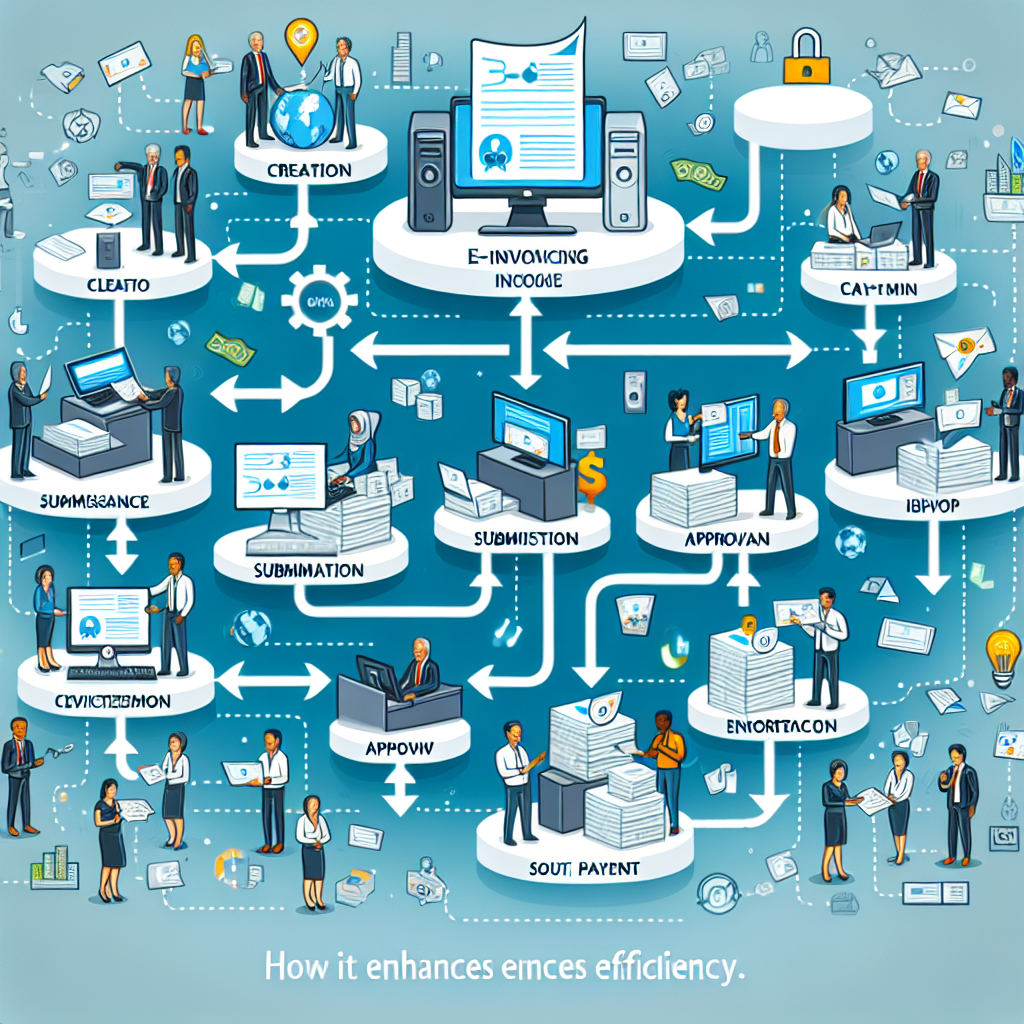-
Table of Contents
Benefits of Electronic Invoicing for Businesses
Electronic Invoicing: How It Works and Enhances Efficiency
In today’s fast-paced business world, efficiency is key to staying competitive. One area where businesses can significantly improve efficiency is in their invoicing process. Traditional paper-based invoicing can be time-consuming, prone to errors, and costly. That’s where electronic invoicing comes in. By digitizing the invoicing process, businesses can streamline operations, reduce costs, and improve cash flow. In this article, we will explore the benefits of electronic invoicing for businesses.
First and foremost, electronic invoicing eliminates the need for paper invoices. Instead of printing, mailing, and manually processing invoices, businesses can send and receive invoices electronically. This not only saves time but also reduces the risk of errors. With electronic invoicing, there is no need to worry about lost or misplaced invoices, as everything is stored digitally and can be easily accessed when needed.
Furthermore, electronic invoicing allows for faster invoice processing. Traditional paper-based invoicing can be a lengthy process, involving multiple steps and approvals. With electronic invoicing, invoices can be generated, sent, and received instantly. This means that businesses can get paid faster, improving cash flow and reducing the need for manual follow-ups.
Another benefit of electronic invoicing is the ability to automate certain tasks. With electronic invoicing software, businesses can set up automatic reminders for overdue payments, schedule recurring invoices, and even integrate with accounting systems. This automation not only saves time but also reduces the risk of human error. By automating repetitive tasks, businesses can free up their employees’ time to focus on more strategic activities.
Additionally, electronic invoicing provides businesses with better visibility and control over their invoicing process. With traditional paper-based invoicing, it can be challenging to track the status of invoices and identify bottlenecks. Electronic invoicing software provides real-time visibility into the invoicing process, allowing businesses to track invoices, monitor payment statuses, and identify any issues that need to be addressed. This increased visibility and control can help businesses identify areas for improvement and make informed decisions to enhance efficiency.
Moreover, electronic invoicing can help businesses reduce costs. Paper, printing, and postage expenses can add up quickly, especially for businesses that deal with a high volume of invoices. By eliminating the need for paper invoices, businesses can significantly reduce these costs. Additionally, electronic invoicing reduces the risk of errors, such as duplicate invoices or incorrect calculations, which can lead to costly disputes and delays in payment.
Lastly, electronic invoicing promotes sustainability. By going paperless, businesses can contribute to environmental conservation efforts. The reduction in paper usage and waste can have a positive impact on the environment. Furthermore, electronic invoicing eliminates the need for physical storage space for paper invoices, freeing up valuable office space.
In conclusion, electronic invoicing offers numerous benefits for businesses. By digitizing the invoicing process, businesses can streamline operations, reduce costs, improve cash flow, and enhance efficiency. With faster invoice processing, automation of tasks, better visibility and control, reduced costs, and environmental sustainability, electronic invoicing is a game-changer for businesses looking to stay ahead in today’s competitive business landscape.
Streamlining Invoice Processing with Electronic Invoicing
Electronic Invoicing: How It Works and Enhances Efficiency
In today’s fast-paced business world, efficiency is key. Companies are constantly seeking ways to streamline their processes and reduce costs. One area that often presents challenges is invoice processing. Traditional paper-based invoicing can be time-consuming, prone to errors, and costly. However, with the advent of electronic invoicing, businesses can now enjoy a more efficient and streamlined approach to managing their invoices.
So, how does electronic invoicing work? Essentially, electronic invoicing, also known as e-invoicing, is the process of sending and receiving invoices electronically, rather than through traditional paper-based methods. This is made possible through the use of technology, such as electronic data interchange (EDI) or web-based platforms.
When a company adopts electronic invoicing, they can create and send invoices directly from their accounting software or invoicing system. The invoice is then transmitted electronically to the recipient, who can receive and process it using their own electronic systems. This eliminates the need for printing, mailing, and manual data entry, saving both time and resources.
One of the key advantages of electronic invoicing is the enhanced efficiency it brings to the invoice processing workflow. With traditional paper-based invoicing, invoices often get lost in the mail or misplaced within an organization. This can lead to delays in payment and frustration for both the sender and the recipient. However, with electronic invoicing, invoices are delivered instantly and can be easily tracked, ensuring timely receipt and processing.
Furthermore, electronic invoicing eliminates the need for manual data entry. With paper-based invoices, employees must manually input the invoice details into their accounting system, which is not only time-consuming but also prone to errors. Electronic invoicing automates this process, as the invoice data can be directly imported into the recipient’s accounting software. This reduces the risk of data entry errors and frees up employees’ time to focus on more value-added tasks.
Another benefit of electronic invoicing is the cost savings it offers. Traditional paper-based invoicing involves costs such as printing, postage, and storage. These costs can quickly add up, especially for businesses that deal with a high volume of invoices. Electronic invoicing eliminates these expenses, as invoices are sent and received electronically. Additionally, electronic invoicing reduces the need for physical storage space, as invoices can be stored digitally, saving both physical space and the associated costs.
In addition to streamlining the invoice processing workflow and reducing costs, electronic invoicing also offers improved accuracy and security. With electronic invoicing, there is less room for human error, as the invoice data is automatically transferred from one system to another. This reduces the risk of data entry mistakes and ensures that the invoice details are accurately recorded.
Furthermore, electronic invoicing enhances security by reducing the risk of invoice fraud. Paper-based invoices can be easily tampered with or intercepted during the mailing process. Electronic invoicing, on the other hand, offers secure transmission of invoices, protecting sensitive financial information and reducing the risk of fraudulent activities.
In conclusion, electronic invoicing is a game-changer for businesses looking to streamline their invoice processing and enhance efficiency. By eliminating the need for paper-based invoices, electronic invoicing saves time, reduces costs, improves accuracy, and enhances security. As technology continues to advance, more and more businesses are embracing electronic invoicing as a way to stay competitive in today’s fast-paced business environment.
How Electronic Invoicing Reduces Costs and Saves Time

Electronic Invoicing: How It Works and Enhances Efficiency
In today’s fast-paced business world, efficiency is key. Companies are constantly looking for ways to streamline their processes and reduce costs. One area where significant improvements can be made is in the invoicing process. Traditional paper-based invoicing can be time-consuming and prone to errors. However, with the advent of electronic invoicing, businesses can now enjoy a more efficient and cost-effective way of managing their invoices.
Electronic invoicing, also known as e-invoicing, is the process of sending and receiving invoices electronically, rather than through traditional mail. It involves the use of technology to automate the creation, delivery, and processing of invoices. By eliminating the need for paper, envelopes, and postage, e-invoicing offers several benefits that can greatly enhance efficiency.
One of the primary advantages of electronic invoicing is the reduction in costs. With traditional paper-based invoicing, businesses incur expenses for printing, postage, and storage. These costs can quickly add up, especially for companies that deal with a large volume of invoices. By switching to e-invoicing, businesses can eliminate these expenses and allocate their resources more effectively.
Furthermore, electronic invoicing saves time. With traditional invoicing, the process can be quite labor-intensive. Employees must manually create, print, and mail each invoice, which can be time-consuming and prone to errors. In contrast, e-invoicing automates these tasks, allowing invoices to be generated and sent with just a few clicks. This not only saves time but also reduces the risk of mistakes, such as incorrect calculations or missing information.
Another way that electronic invoicing enhances efficiency is through faster payment processing. With traditional invoicing, there can be delays in receiving payments due to the time it takes for invoices to be delivered and processed. E-invoicing eliminates these delays by enabling invoices to be sent instantly and received in real-time. This allows businesses to get paid faster, improving cash flow and reducing the need for follow-up reminders.
Moreover, electronic invoicing offers greater visibility and transparency. With traditional invoicing, it can be challenging to track the status of invoices and monitor payment history. E-invoicing provides businesses with a centralized platform where they can easily access and manage all their invoices. This allows for better tracking, reporting, and analysis, enabling businesses to make more informed decisions and identify areas for improvement.
In addition to these benefits, electronic invoicing also promotes sustainability. By eliminating the need for paper, e-invoicing helps reduce the environmental impact associated with traditional invoicing. It contributes to a greener business environment and aligns with corporate social responsibility initiatives.
In conclusion, electronic invoicing is a game-changer for businesses looking to enhance efficiency and reduce costs. By eliminating the need for paper, e-invoicing streamlines the invoicing process, saving time and reducing the risk of errors. It also enables faster payment processing, improves visibility and transparency, and promotes sustainability. With these advantages, it’s no wonder that more and more businesses are making the switch to electronic invoicing.
Enhancing Efficiency and Accuracy with Electronic Invoicing
Electronic Invoicing: How It Works and Enhances Efficiency
In today’s fast-paced business world, efficiency and accuracy are crucial for success. One area where businesses can significantly improve efficiency is in their invoicing process. Traditional paper-based invoicing can be time-consuming, prone to errors, and costly. However, with the advent of electronic invoicing, businesses can streamline their invoicing process, reduce errors, and enhance overall efficiency.
Electronic invoicing, also known as e-invoicing, is the process of sending and receiving invoices electronically, eliminating the need for paper-based invoices. Instead of printing, mailing, and manually processing invoices, businesses can now generate, send, and receive invoices electronically, saving time and resources.
The process of electronic invoicing begins with the generation of an electronic invoice. This can be done using specialized software or online platforms that allow businesses to create professional-looking invoices. These invoices can be customized with company logos, payment terms, and other relevant information. Once the invoice is generated, it can be sent directly to the customer’s email address or uploaded to a secure online portal for the customer to access.
One of the key advantages of electronic invoicing is the speed at which invoices can be sent and received. With traditional paper-based invoicing, invoices can take days or even weeks to reach the customer. However, with electronic invoicing, invoices can be sent instantly, allowing businesses to get paid faster. This not only improves cash flow but also reduces the time spent on chasing late payments.
In addition to speed, electronic invoicing also enhances accuracy. Manual data entry is prone to errors, which can lead to payment delays and disputes. With electronic invoicing, the risk of errors is significantly reduced. The software or online platforms used for electronic invoicing often have built-in validation checks that ensure all required information is included and entered correctly. This reduces the likelihood of errors and ensures that invoices are accurate and complete.
Furthermore, electronic invoicing allows for better tracking and monitoring of invoices. Businesses can easily keep track of which invoices have been sent, which ones have been paid, and which ones are still outstanding. This real-time visibility into the invoicing process enables businesses to take proactive measures to follow up on unpaid invoices and resolve any issues promptly.
Another advantage of electronic invoicing is the cost savings it offers. Traditional paper-based invoicing involves costs such as printing, postage, and storage. These costs can quickly add up, especially for businesses that deal with a large volume of invoices. With electronic invoicing, these costs are eliminated or significantly reduced. Businesses no longer need to spend money on paper, ink, envelopes, and postage. Additionally, electronic invoices can be stored digitally, saving physical storage space and reducing the risk of document loss or damage.
In conclusion, electronic invoicing is a game-changer for businesses looking to enhance efficiency and accuracy in their invoicing process. By eliminating the need for paper-based invoices, businesses can save time, reduce errors, and improve overall efficiency. The speed at which invoices can be sent and received, the enhanced accuracy, better tracking and monitoring capabilities, and the cost savings make electronic invoicing a valuable tool for businesses of all sizes. Embracing electronic invoicing is not only a smart business move but also a step towards a more sustainable and environmentally friendly future.
The Future of Electronic Invoicing: Trends and Innovations
The Future of Electronic Invoicing: Trends and Innovations
In today’s fast-paced business world, efficiency is key. Companies are constantly looking for ways to streamline their processes and reduce costs. One area that has seen significant advancements in recent years is electronic invoicing. This method of invoicing has revolutionized the way businesses send and receive payments, making the process faster, more accurate, and more cost-effective.
One of the trends that is shaping the future of electronic invoicing is the move towards cloud-based solutions. Cloud-based invoicing platforms offer a number of benefits over traditional on-premise systems. For one, they allow businesses to access their invoicing data from anywhere, at any time. This means that invoices can be processed and paid more quickly, leading to improved cash flow. Additionally, cloud-based solutions often come with built-in automation features, such as automatic payment reminders and recurring invoicing. These features not only save time but also reduce the risk of human error.
Another trend that is gaining traction in the world of electronic invoicing is the use of artificial intelligence (AI) and machine learning. AI-powered invoicing systems can analyze large amounts of data and identify patterns and trends that humans may miss. This can help businesses make more informed decisions about their invoicing processes, such as when to send reminders or how to optimize payment terms. Machine learning algorithms can also learn from past invoice data to predict future payment behavior, allowing businesses to better manage their cash flow.
Blockchain technology is also making waves in the world of electronic invoicing. Blockchain is a decentralized ledger that records transactions across multiple computers. This technology offers a high level of security and transparency, making it ideal for invoicing. With blockchain, each invoice is recorded as a block, and once it is added to the chain, it cannot be altered or tampered with. This eliminates the risk of fraud and ensures that all parties involved in the invoicing process have access to the same, up-to-date information.
In addition to these trends, there are also a number of innovations on the horizon that could further enhance the efficiency of electronic invoicing. For example, some companies are exploring the use of smart contracts in invoicing. Smart contracts are self-executing contracts with the terms of the agreement directly written into code. This means that once certain conditions are met, such as the completion of a service or the delivery of goods, the payment is automatically triggered. This eliminates the need for manual invoicing and reduces the risk of late or missed payments.
Another innovation that could revolutionize electronic invoicing is the use of digital currencies, such as Bitcoin. Digital currencies offer a number of advantages over traditional currencies, including lower transaction fees and faster processing times. By accepting digital currencies as payment, businesses can further streamline their invoicing processes and reduce costs.
In conclusion, electronic invoicing is the way of the future. With advancements in cloud-based solutions, AI and machine learning, blockchain technology, and innovations such as smart contracts and digital currencies, the efficiency of invoicing processes will continue to improve. Businesses that embrace these trends and innovations will not only save time and money but also gain a competitive edge in today’s fast-paced business world.
Q&A
1. What is electronic invoicing?
Electronic invoicing, also known as e-invoicing, is the process of creating, sending, receiving, and processing invoices electronically, without the need for paper documents.
2. How does electronic invoicing work?
Electronic invoicing involves the use of specialized software or platforms that enable businesses to generate digital invoices, which are then sent to customers via email or other electronic means. The invoices can be easily tracked, managed, and stored electronically.
3. What are the benefits of electronic invoicing?
Electronic invoicing offers several advantages, including improved efficiency, reduced costs, faster payment processing, enhanced accuracy, and better visibility into the invoicing process. It also helps businesses save time and resources by automating manual tasks.
4. How does electronic invoicing enhance efficiency?
Electronic invoicing streamlines the entire invoicing process by eliminating manual tasks such as printing, mailing, and data entry. It reduces the chances of errors and delays, enables faster invoice delivery, and allows for automated payment reconciliation. This ultimately enhances efficiency and productivity for businesses.
5. Are there any legal requirements for electronic invoicing?
Different countries have varying legal requirements for electronic invoicing. It is important for businesses to comply with these regulations, such as ensuring the authenticity, integrity, and legibility of electronic invoices.








